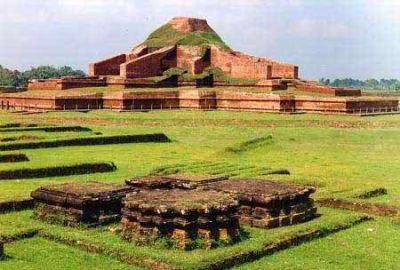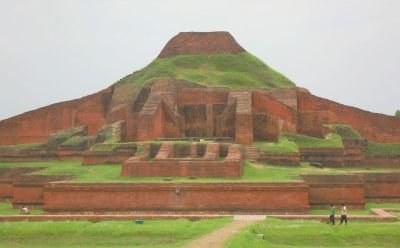
Sompur Bihar, according to the information obtained from the inscription, its fullname is Shree Somapura-Shree-Dharmapaldev-Mahavihara-Bhikshu Sangha. Many scholars believe that this is the largest Buddhist temple in the world. Among the three UNESCO World Heritage sites located in Bangladesh, this monastery is one of the best.
At one glance the history of Paharpur
Sompur Bihar is located in the northern part of Bangladesh, in Badalgachi upazila, in Paharpur union. So Sompur Bihar known as Paharpur Buddhist Bihar. Pal dynasty ruled from ancient Buddhas in the last four centuries of Buddhism. Originally the Pal kingdom of Bengal and Bihar, it spread to the Khyber-Pakhtunkhwa of Pakistan in the north-west of the final stage of success. Pal dynasty kings were devoted Buddhists. It is believed that Sompur Buddhist Bihara was built during the king Dharmapal, the second king of Pal dynasty. But many people also believed that king Dharmapal was not built this his son, King Devapala, who was the builder of this monastery, the author of the famous Tibetan history book "Pag Sam Zahan Zhang", very clearly mentioned the huge monastery and high-rise temple built in Sompur by Devapala (810-850), son of Dharmapala. However, whichever time the construction of Sompur Bihar is unique in the architecture industry and the largest in size.

From the distance Paharpur Bihar looks just like the mountain.
These huge structures, which were buried under the mound of the soil for the long time, looks like a mountains from far. Apart from the various places in the Indian subcontinent, Buddhists from other countries such as China, Tibet, Myanmar, Malaysia, Indonesia etc. used to come here to achieve religion and religious science. In the tenth century AD, Atish Dipankar Shrigyan was the Acharya of Bihar. The greatness of his knowledge is reached beyond the boundaries of Bengal, to faraway Tibet. In Tibet, he had solved there water problem. The house of this great scholar was in the village of Bajrajagini of Bikrampur near Dhaka.
This structure is found at the time of the land survey of the English period, in the middle of 1807-1812. Then Sir Alexander Kannimham carried out partial excavation work in 1879 and the Department of Archeology in British India in the 1920s. After the liberation of Bangladesh, its excavation work began in the early 1980's, and in 1985 UNESCO declared it as a World Heritage Site.
Calculation of the architectural industry of Paharpur
The Bihar is spread over 27 acres of land. It has 177 rooms. The huge temple in the middle looks like a mountain from a distance. The temple basement cruciform. The length of each crucifixion is 108.3m and 95.45m In the middle, a few more additional walls are connected angled and there is a vacuum chamber-walled cell without doors and windows. This chamber stretches from the bottom of the temple to a peak. It is basically the center of this empty chamber built on the structure of the temple. The current height of the temple is 21 meters. However, it is believed that at one time it may have been more than 30 meters higher than the height of this temple. However, according to locals of Naogaon area, the main temple is going to die day by day, the excavation work in the 1980s was more than the height of the beginning or more than now. Terracotta work is found on the main temple wall. Terracotta has been made in the form of different types of statues.

The imagination of the artists who made this thousands of years ago in the Terracotta
The temple were surrounded by the cells. It was believed that the Tantric devotees and students of monks coming from distant places stayed in these houses. The length of the rooms is roughly 4.26 meters and the width is 4.11 meters. The rooms are surrounded by the square as the square of the original temple. On the north there are 45 in one row and the remaining three is 44. During the Pala period of Somnath Bihar only, many Buddhist Bengalis developed in Bengal and Bihar. According to the Tibetan tradition, there are five major monasteries during which the remaining four are: Vikramashila, Nalanda, Vedanta, and Jagadal Bihar, of Rajshahi. These monasteries had regular interaction with each other, and much like the day at the inter-university Collaboration.
There was no trace of the monastery being sudden destroyed. But it is believed that after the Muslim conquest of Bengal, due to the decline of Buddhist rule, the rise of the Hindu principality and, above all, the Bihar was once again abandoned due to the decline of the monastery in the neo-political landscape. It's almost eighty years ago from today.
The ruins of Somnath Bihar, which was built almost twelve hundred years ago, will take you away for a short time. In the last afternoon, the brilliant brightness of each brick will remind you of a civilization which is buried in a soil suppressed.
If you like my post then please upvote my post. U can also follow me @pinkayesh and also resteem my post.
Me encanta leer sobre ese tipo de temas, te doy mi voto : )
thank u
I visited there when I was at class 7th
Congratulations! This post has been upvoted from the communal account, @minnowsupport, by pinkayesh from the Minnow Support Project. It's a witness project run by aggroed, ausbitbank, teamsteem, theprophet0, someguy123, neoxian, followbtcnews, and netuoso. The goal is to help Steemit grow by supporting Minnows. Please find us at the Peace, Abundance, and Liberty Network (PALnet) Discord Channel. It's a completely public and open space to all members of the Steemit community who voluntarily choose to be there.
If you would like to delegate to the Minnow Support Project you can do so by clicking on the following links: 50SP, 100SP, 250SP, 500SP, 1000SP, 5000SP.
Be sure to leave at least 50SP undelegated on your account.
This post has received gratitude of 1.30 % from @appreciator thanks to: @pinkayesh.